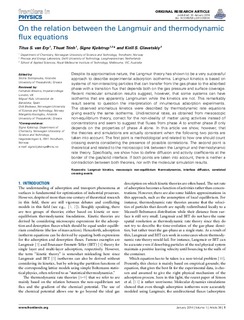| dc.contributor.author | van Erp, Titus Sebastiaan | |
| dc.contributor.author | Trinh, Thuat | |
| dc.contributor.author | Kjelstrup, Signe | |
| dc.contributor.author | Glavatskiy, Kirill | |
| dc.date.accessioned | 2015-09-22T12:05:06Z | |
| dc.date.accessioned | 2016-05-12T09:32:06Z | |
| dc.date.available | 2015-09-22T12:05:06Z | |
| dc.date.available | 2016-05-12T09:32:06Z | |
| dc.date.issued | 2014-01-22 | |
| dc.identifier.citation | Frontiers in Physics 2014, 36(1) | nb_NO |
| dc.identifier.issn | 2296-424X | |
| dc.identifier.uri | http://hdl.handle.net/11250/2389254 | |
| dc.description.abstract | Despite its approximative nature, the Langmuir theory has shown to be a very successful approach to describe experimental adsorption isotherms. Langmuir kinetics is based on systems of non-interacting particles that can transfer from the gas phase to the adsorbed phase with a transition flux that depends both on the gas pressure and surface coverage. Recent molecular simulation results suggest, however, that some systems can have isotherms that are apparently Langmuirian while the kinetics are not. This remarkably result seems to question the interpretation of innumerous adsorption experiments. The observed anomalous kinetics were described by thermodynamic rate equations giving exactly the same isotherms. Unidirectional rates, as obtained from mesoscopic non-equilibrium theory, correct for the non-ideality of matter using activities instead of concentrations and seem to suggest that fluxes from phase A to another phase B only depends on the properties of phase A alone. In this article we show, however, that the theories and simulations are actually consistent when the following two points are taken into account. The first point is methodological and related to how one should count crossing events considering the presence of possible correlations. The second point is theoretical and related to the microscopic link between the Langmuir and thermodynamic rate theory. Specifically, we show how to define diffusion and activity coefficients at the border of the gas/solid interface. If both points are taken into account, there is neither a contradiction between both theories, nor with the molecular simulation results. | nb_NO |
| dc.language.iso | eng | nb_NO |
| dc.publisher | Frontiers Media | nb_NO |
| dc.rights | Navngivelse 3.0 Norge | * |
| dc.rights.uri | http://creativecommons.org/licenses/by/3.0/no/ | * |
| dc.title | On the relation between the Langmuir and thermodynamic flux equations | nb_NO |
| dc.type | Journal article | nb_NO |
| dc.type | Peer reviewed | nb_NO |
| dc.date.updated | 2015-09-22T12:05:06Z | |
| dc.source.volume | 36 | nb_NO |
| dc.source.journal | Frontiers in Physics | nb_NO |
| dc.source.issue | 1 | nb_NO |
| dc.identifier.doi | 10.3389/fphy.2013.00036 | |
| dc.identifier.cristin | 1071009 | |
| dc.description.localcode | Copyright © 2014 van Erp, Trinh, Kjelstrup and Glavatskiy. This is an open-access article distributed under the terms of the Creative Commons Attribution License (CC BY). The use, distribution or reproduction in other forums is permitted, provided the original author(s) or licensor are credited and that the original publication in this journal is cited, in accordance with accepted academic practice. No use, distribution or reproduction is permitted which does not comply with these terms. | nb_NO |

